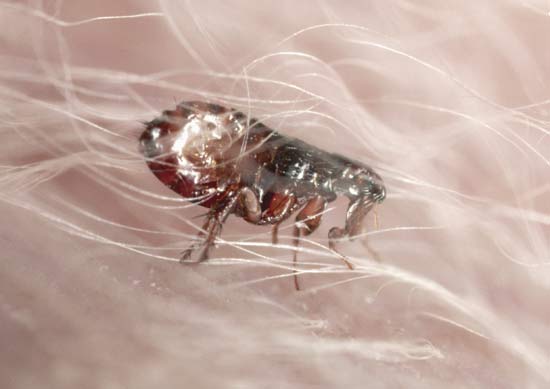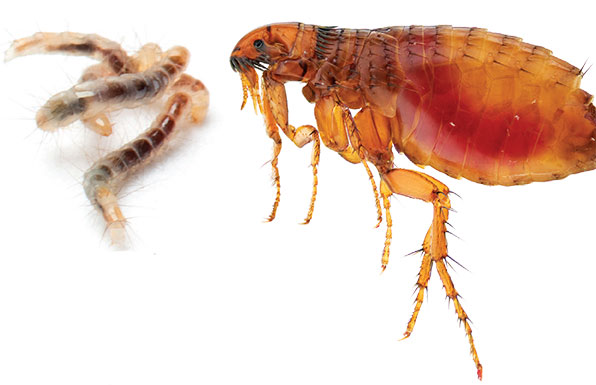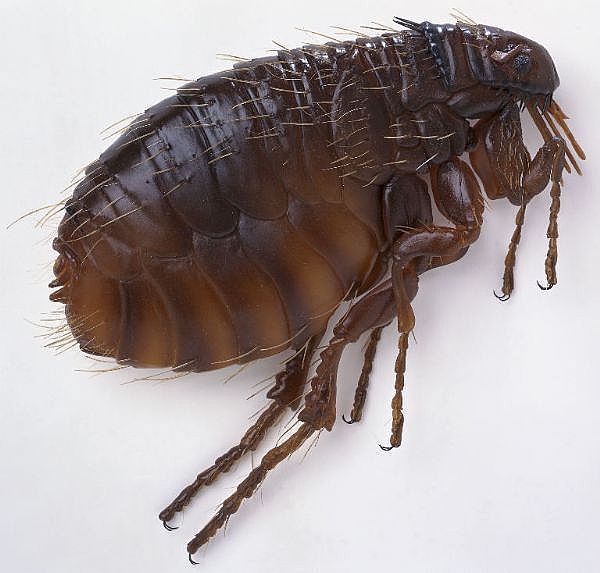

Fleas are a type of wingless parasite found worldwide. They feed off the blood of humans and animals such as dogs and cats.

Fleas undergo complete metamorphosis. The lif Since fleas use a wide range of hosts, diseases can be transferred from one host to another. Fleas are known to transmit tapeworm larvae and, uncommonly, the disease murine typhus. They are most notorious for transmitting bubonic plague from wild rodents to humans in certain parts of the world .
Fleas undergo complete metamorphosis. The life cycle, or stages, of the flea is composed of the egg, larval, pupal and adult stages. Cycle length ranges from several weeks to several months and is largely dependent upon environmental conditions.
Fleas lay between four to eight eggs after a meal, with the highest concentrations of laying occurring within the last few days of the female’s life. Unlike the eggs of some other parasites, flea eggs are not sticky and usually fall to the ground immediately upon being laid. Flea eggs hatch into larvae within one to 12 days.
Flea larvae are approximately 3 to 5.2 mm long and are semitransparent white in color. The larval stage lasts from four to 18 days, after which larvae spin silken cocoons and enter the pupal stage. The pupal stage may be complete within three days, or it can last as long as one year.
Flea larvae complete three larval instars (stages) and, depending on their environment, will range in length from about 3-5 mm long. Flea larvae have no eyes and no legs. Their body is maggot-like and whitish, but turns progressively darker as the larvae feeds on feces excreted by the adult fleas. Other than feces, larvae will feed on various types of organic matter such as food particles, dead skin, dead insects and feathers. Flea larvae do not take a blood meal directly from a host, unlike adult fleas. The flea’s larval stage is completed within about 4-18 days. One of the last activities of flea larvae is to spin a silken cocoon and then enter the pupal stage.
Adult fleas begin searching for food when they emerge from the pupal stage. While fleas are noted for their jumping abilities, they will remain stationery when a suitable host is located. Females begin laying eggs within 48 hours of the first feed, thus beginning the life cycle again. Cold environments cause eggs to perish before hatching. Humidity below 45 percent will kill larvae. Fleas in the pupal stage will become adults more rapidly in the presence of warmth and high humidity.
Your local council can offer information and advice on dealing with a flea infestation. Some general suggestions on eliminating fleas yourself include:



If we look at pricing holistically, we'll create a more solid business.
Services Frequency
1 Exterior Services
1 Interior Services
Free Call Back
Bees, Ground Ants, Spiders, Bugs, Pill Bugs, Rats.
Services Frequency
2 Exterior Services
2 Interior Services
Free Call Back
Bees, Ground Ants, Spiders, Bugs, Pill Bugs, Rats.
Services Frequency
Three Exterior Services
Three Interior Services
Free Call Back
Bees, Ground Ants, Spiders, Bugs, Pill Bugs, Rats.